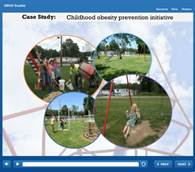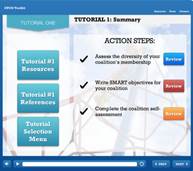 |
December 2017
|
December 2017 // Volume 55 // Number 6 // Tools of the Trade // v55-6tt1
Mobilizing Rural Communities to Prevent Childhood Obesity: A Tool Kit
Abstract
The tool kit Mobilizing Rural Communities to Prevent Childhood Obesity is the product of a seven-state multidisciplinary research project focused on enhancing obesity prevention efforts by integrating community coaching into the work of rural community coalitions. The interactive tool kit is available at no cost both in print form and online, and it consists of five tutorials that present best practices and lessons learned throughout the research project. Extension professionals working within health promotion coalitions may wish to use or promote the tool kit. Coalition members can complete the activities contained in the tool kit individually or as a group.
Introduction
Approximately one third of preschool-aged children are overweight or obese (Ogden, Carroll, Kit, & Flegal, 2014). Additionally, the Center for Study of Rural America reports that people in rural areas of the country experience higher rates of obesity than those living in urban and suburban communities (Henderson & Low, 2006). Although most states have obesity prevention plans, they tend to overlook the unique needs and challenges of rural communities, such as lack of infrastructure supporting daily physical activity and fewer opportunities to purchase nutritious food (Friedrich, 2007; Moore et al., 2010).
Cooperative Extension's National Framework for Health and Wellness (Braun et al., 2014), which is based on Bronfenbrenner's (1979) social-ecological model, recognizes the myriad of social, environmental, and economic factors that affect one's health, such as the infrastructure—or lack thereof—of rural communities. The 2014 framework report also acknowledges that county Extension professionals "have the community presence and local credibility needed to influence the social, economic, and environmental determinants of health" (p. 2). The new tool kit Mobilizing Rural Communities to Prevent Childhood Obesity provides resources and interactive approaches for Extension professionals to use when working with rural community health coalitions to address determinants of health, especially those pertaining to the weight statuses of young children.
Development of the Tool Kit
In 2010, a seven-state multidisciplinary research team of Extension professionals, nutrition scientists, family development specialists, and community development experts formed to respond to the White House Task Force on Childhood Obesity's (2010) report Solving the Problem of Childhood Obesity within a Generation. Collectively, this research team, of which we were part, proposed a research project to test interventions for preventing and reducing obesity among preschool-aged children in rural communities in the Midwest. The research team received funding to implement the project over a 5-year period.
Two rural communities from each state represented by the research team participated in the project. An existing health coalition in each community was asked to create and implement a plan to prevent or reduce childhood obesity in the community. The research team provided each coalition with environmental assessment tools, an electronic "menu" of evidence-based and evidence-informed obesity prevention/reduction strategies, and up to $5,000 annually for implementation of at least one nutrition and one physical activity strategy per year. Additionally, the research team randomly designated one community in each state as an intervention community and provided the coalition in each intervention community with a trained community coach. The role of the community coach was to help coalition members use their environmental assessments to identify community needs and select obesity prevention strategies to implement. The quasi-experimental design of the research project allowed the research team to test the hypothesis that community coaching enhances the capacity of communities to address identified needs, resulting in greater behavior change in nutrition and physical activity among parents, caregivers, childcare providers, and others providing services to 4-year-old children (Peters et al., 2016).
Throughout the project, the research team compiled best practices and lessons learned and synthesized them into the peer-reviewed resource Mobilizing Rural Communities to Prevent Childhood Obesity. The resource consists of five sections:
- Is Your Coalition Ready to Make a Change in Childhood Obesity?
- Considering Levels of Community Change
- Using Evidence-Based Strategies and Interventions: Choosing What Works
- Using a Community Coach to Help Your Coalition Identify and Reach Its Target
- Introducing Program Evaluation and Tools to Your Coalition
Each section contains learning activities and action steps for coalition members to complete as a group, case studies from coalitions participating in the research project, "skeptic questions" that address common concerns, and resources that coalition members can use for further professional development. Coalition members can select the topics of interest to them and move through topics in whatever order they choose. The tool kit is available at no charge in print form at go.osu.edu/CPCOtoolkitpdf and as a set of online self-paced, interactive learning modules titled Communities Preventing Childhood Obesity: A Toolkit at go.osu.edu/CPCOtoolkit (Figure 1).
Figure 1.
Screenshots from the Online Resource Communities Preventing Childhood Obesity: A Toolkit



Implications
Cooperative Extension's National Framework for Health and Wellness calls for Extension professionals to engage with partners in various sectors of the community to increase the number of Americans who are healthy at every stage of life. One way many Extension professionals form and sustain community partnerships is through community coalitions. In a 2014 survey of Extension professionals working for a large midwestern university, two thirds of respondents indicated involvement in community coalitions either as active participants or as support or resource people (Smathers & Lobb, 2015). More than one third of respondents represented rural counties, and over half identified health promotion as the primary focus of the coalitions with which they worked (Smathers & Lobb, 2015). Skills identified as most beneficial to their work with coalitions included maintaining and sustaining coalitions, coaching coalitions for success, coalition development, fundraising and grant writing for coalitions, and obtaining tax-exempt status for coalitions (Smathers & Lobb, 2015).
Extension professionals can use the Mobilizing Rural Communities to Prevent Childhood Obesity tool kit to help coalitions
- assess community environments to identify health-related assets and needs;
- capitalize on community assets when implementing interventions;
- identify, select, and use evidence-based approaches to childhood obesity prevention;
- evaluate the effectiveness of group interventions aimed at changing environments; and
- take steps toward strengthening a coalition's structure, operations, leadership, communications, and/or group cohesion.
Extension professionals also can use the resource to learn about the use of community coaching strategies within coalitions. Community coaching is a specific type of coaching that provides guidance to groups in identifying and achieving their goals. The tool kit specifies approaches for implementing community coaching techniques, such as active listening, powerful questioning, and critical reflection. It explores potential roles of a community coach, provides guidance for identifying individuals who may have coaching skills, and outlines basic coaching activities a coalition can put into practice. Furthermore, it applies the community coaching model specifically to community health coalitions.
The tool kit is unique in its focus on rural communities. This resource can enhance Extension professionals' roles as leaders and subject area experts for coalitions serving rural populations by providing them with targeted content, activities, and assessment tools to help coalitions create healthier communities.
Acknowledgments
We would like to acknowledge the following groups of individuals:
- Research team members—Dawn Contreras, director, Health and Nutrition Institute, Michigan State University Extension; Renee Oscarson, associate professor, Human Development and Family Studies, South Dakota State University; Abby Gold, vice chair and associate professor, Department of Public Health, College of Health Professions, North Dakota State University; Ann L. Keim, interim state program director, Family Living Programs, Cooperative Extension, University of Wisconsin–Extension; Amy R. Mobley, Department of Nutritional Sciences, University of Connecticut; Paula Peters, assistant director, Family and Consumer Sciences, Kansas State Research and Extension; Sandy Procter, Extension specialist, Department of Human Nutrition, Kansas State University; Valentina Remig, project coordinator, Kansas State University Research and Extension.
- Community coaching training staff—Dan Kahl, assistant professor, Community and Leadership Development, University of Kentucky; Myles Alexander, community, natural resources, and economic development agent, University of Wisconsin–Extension.
- Project support team members—graduate students and community coaches from each state.
The project described herein was supported by the Agriculture and Food Research Initiative, Grant Number #2011-68001-30100, from the U.S. Department of Agriculture, National Institute of Food and Agriculture, Childhood Obesity Prevention: Integrated Research, Education and Extension to Prevent Childhood Obesity, Program Code A2101.
References
Braun, B., Bruns, K., Cronk, L., Fox, L. K., Koukel, S., LeMenestrel, S., . . . & Warren, T. (2014). Cooperative Extension's national framework for health and wellness. Retrieved from http://www.aplu.org/members/commissions/food-environment-and-renewable-resources/CFERR_Library/national-framework-for-health-and-wellness/file
Bronfenbrenner, U. (1979). The ecology of human development: Experiments by nature and design. Cambridge, MA: Harvard University Press.
Friedrich, M. (2007). Researchers address childhood obesity through community based programs. Journal of the American Medical Association, 298, 2728–2730.
Henderson, J., & Low, S. (2006). Obesity: America's economic epidemic. Retrieved from https://www.kansascityfed.org/publicat/mse/MSE_02_06.pdf
Ogden, C. L., Carroll, M. D., Kit, B. K., & Flegal, K. M. (2014). Prevalence of childhood and adult obesity in the United States, 2011–2012. Journal of the American Medical Association, 311(8), 806–814.
Moore, J. B., Jilcott, S. B., Shores, K. A., Evenson, K. R., Brownson, R. C., & Novick, L. F. (2010). A qualitative examination of perceived barriers and facilitators of physical activity for urban and rural youth. Health Education Research, 25, 355–367.
Peters, P., Gold, A., Abbott, A., Contreras, D., Keim, A., Oscarson, R. . . . Mobley, A. R. (2016). A quasi-experimental study to mobilize rural low-income communities to assess and improve the ecological environment to prevent childhood obesity. BMC Public Health, 16, 376. Retrieved from http://bmcpublichealth.biomedcentral.com/articles/10.1186/s12889-016-3047-4
Smathers, C. A., & Lobb, J. M. (2015). Extension professionals and community coalitions: Professional development opportunities related to leadership and policy, system, and environment change. Journal of Extension, 53(6), Article 6FEA1. Available at: https://www.joe.org/joe/2015december/a1.php
White House Task Force on Childhood Obesity. (2010). Report to the president: Solving the problem of childhood obesity within a generation. Retrieved from http://www.letsmove.gov/white-house-task-force-childhood-obesity-report-president




